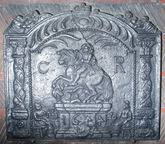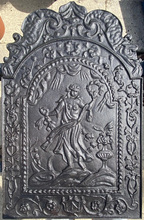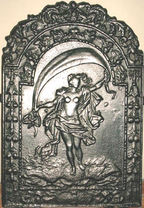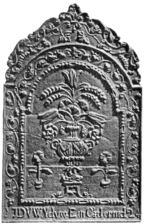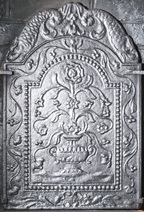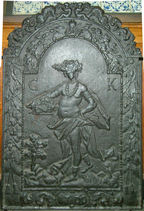-
280
Description: Arched rectangular shaped central panel, bead edging (top and sides), pedestal bearing a supine male figure with headband being trampled by a horse, facing left, mounted by a rider with long hair, facing to the front; on each side of the plinth is a seated figure wearing a hat, with a basket of fruit; above the rider are crescent lines representative of clouds; the inscription is split either side of the horse; the date (‘7’ rotated and, with ‘4’, reversed) is on the die of the pedestal; arched rectangular shaped border, fillet edging, on each side a Solomonic column with vine decoration; in the arch, symmetrical parallel curved lines with a central oval cartouche beneath a crown; on top of each shoulder of the plate a figure in repose.
Notes: The equestrian figure is derived from the statue of Charles II erected in Stocks Market, London, in 1672. Originally to be of Jan Sobieski, later king of Poland, riding down a Tatar, it was altered to represent Charles, and the Tatar’s face was changed to that of Oliver Cromwell; the statue attracted a fair degree of derision. The statue is now at Newby Hall, near Ripon, North Yorkshire. Another version (no. 464), probably by the same pattern-maker, omits a date and has altered initials. Copies of this fireback were advertised in Bratt Colbran Ltd.'s (London) catalogue, and in the Wayte & Cheverton (Edenbridge) catalogue, in the early-20th century.
Copies of this fireback are known.
Inscription: C R / 1674
- Decoration tags:
- 'Dutch' (shape)
- cavetto (edging)
- whole carved pattern
- individual numbers
- pictorial
- historical
- architectural
- text
- animals
- humans
Manufactured: in 1674 in England.
Current location: Chequers, Ellesborough, Buckinghamshire, England.
Citation: Lloyd, N., 1925, 'Domestic Ironwork I', Architectural Review, 58, pp. 58-67.
- Attached to series:
- Carolean 'Dutch' series
- Commemorative firebacks
-
1119
Description: Arched rectangular central panel with 'nutshell' over fillet edging; pictorial image of a partially clothed female figure, holding an upraised wreath in her left hand, standing on a ground, with a gadrooned vase containing flowers and leaves to the right, and above swagged drapery and sun rays; arched rectangular fillet border with descending leaves and flowers suspended from a wreath, top centre, and a wreath in each top corner; on top, mirrored sea monsters; bottom centre, logo formed of a pair of dividers in a cartouche between swirling fronds.
Notes: The figure is an allegorical representation of Agriculture, one of the Iconologia originally published by Cesare Ripa in 1613. A modern casting of an early-18th century design (see no. 1325). Copies of this fireback were advertised in Burton Weir's (Rotherham) catalogue in the early-20th century.
Copies of this fireback are known.
- Decoration tags:
- 'Dutch' (shape)
- fillet (edging)
- whole carved pattern
- allegorical
- humans
- objects
Manufactured: in the 20th century in England.
Current location: not known.
- Attached to series:
- British 'Dutch' style firebacks
- Agriculture firebacks
-
936
Description: Arched rectangular central panel with triple bead and pellet edging; semi-naked figure of Fortune, holding in her hands a billowing sheet, and standing on a ground; arched rectangular fillet border enclosing suspended swagged flowers and berries (top and sides), with indeterminate foliage on the bottom on either side of an empty cartouche; on top, symmetrical wsirled foliage.
Notes: The design is derived from an engraving by Aegidius Sadeler after a painting by Christoph Schwarz of about 1580-1600. Although not marked as such, other castings of this fireback are marked with the initials, GK, and dated to 1700.
Copies of this fireback are known.
- Decoration tags:
- 'Dutch' (shape)
- fillet (edging)
- whole carved pattern
- pictorial
- allegorical
- humans
Manufactured: in the early-18th century possibly in the Siegerland area of Germany.
Current location: in private hands Haringhuizen, Netherlands.
Citation: Elling, W. & Winkler-Borck, S., 1992, Ofen- und Kaminplatten (Vreden, Hamaland-Museum).
- Attached to series:
- 'Dutch' GK series
-
858
Description: Arched rectangular shaped central panel, bead-and-pellet on fillet edging, narrow-necked, two-handled urn with flowers and wheat ears issuing therefrom, the vase resting on paving, upon which are two small flowers in pots with a stool between; arched rectangular shaped border with fillet edging and symmetrical floral tendrils, a looped 'W' in each shoulder; on top, mirrored leaves, tendrils and wheat ears; inscription along bottom of border.
Notes: One of the two largest of six flower vase designs in this series (see also no. 885). All incorporate the looped 'W' motif which may be intended to identify the pattern maker. The inscription translates as 'God is our strength'. Illustration from Goodwin-Smith, 1936 (from Bratt Colbran Ltd.'s (London) catalogue, in which copies of this fireback were advertised in the early-20th century).
Copies of this fireback are known.
Inscription: 17 DVW Ydyw Ein Cadernid 24
Manufactured: in 1724 in England.
Current location: not known.
Citation: Goodwin-Smith, R., 1936, 'Some English Firebacks', The Connoisseur, 97, pp. 36-8.
- Attached to series:
- 1724 series
- Welsh inscription series
- British 'Dutch' style firebacks
-
1230
Description: Arched rectangular central panel with bead-on-fillet edging; gadrooned vase with a quasi-symmetrical arrangement of fronds, leaves and flowers issuing therefrom, topped by a central bloom; arched rectangular border with fillet edging and a quasi-symmetrical arrangement of fronds, leaves and flowers descending from top centre; at the bottom, leaves splayed from a central cartouche enclosing an indecipherable initial or monogram; on top, symmetrical sea serpents descending from a central beribboned pendant.
Notes: A familiar type of design seen on many small firebacks/grate-backs of this period. Copies were advertised in Longden & Co.'s (Sheffield) catalogue c.1911, and the Carron Company's catalogue.
Copies of this fireback are known.
Inscription: [indecipherable]
Manufactured: in the early-18th century in England.
Current location: Godinton House, Great Chart, Kent, England.
- Attached to series:
- British 'Dutch' style firebacks
-
83
Description: Arched rectangular shaped central panel, bead-and-pellet edging, semi-naked male figure, wearing a floral head-dress and carrying a basket of produce, initials in top corners; arched rectangular shaped border, fillet edging, symmetrical festoons of foliage, floral scrolls at base, date in an oval cartouche; on top, two putti, two dolphins and scrolled foliage, all symmetrical.
Notes: An allegory of Spring, based closely on an engraving, dated 1600, by Hendrik Goltzius (1558-1617); one of a series of large firebacks of similar date, all bearing the initials, GK.
Copies of this fireback are known.
Inscription: G K / 1700
- Decoration tags:
- 'Dutch' (shape)
- fillet (edging)
- whole carved pattern
- individual letters
- date stamp
- pictorial
- allegorical
- text
- humans
Manufactured: in 1700 possibly in the Siegerland area of Germany.
Current location: Guildford Museum, Guildford, Surrey, England.
Museum number: S,7111 (part of the Guildford Museum museum group)
Citation: Pesch, D., 1982, Herdgussplatten (Rheinland-Verlag, Koln).
- Attached to series:
- 'Dutch' GK series
-
77
Description: 'Dutch' style; arched rectangular shaped central panel, bead edging, two children sitting astride a beast (possibly a winged ram); arched rectangular shaped border, fillet edging, swags of fruit bunches suspended from ribbon; on top, symmetrical floral swirls and flowers.
Notes: The image is probably intended to be Phrixus and Helle riding the winged ram with the golden fleece, but in recasting it has been misinterpreted as the young Samson slaying the lion at Timnath; Judges 14: 5-6.
Copies of this fireback are known.
Inscription: 16 NDW 97 / DER JUNGE SAMSON [the young Samson]
- Decoration tags:
- 'Dutch' (shape)
- fillet (edging)
- whole carved pattern
- individual letters
- individual numbers
- biblical
- monogram
- text
- humans
Manufactured: in the late-17th to early-18th century possibly in the Weald area of England.
Current location: Guildford Museum, Guildford, Surrey, England.
Museum number: G.486 (part of the Guildford Museum museum group)
- Attached to series:
- 'Dutch' NDW series
-
82
Description: 'Dutch' style; arched rectangular shaped central panel, bead on fillet edging, naturalistic scene of a heron with wings extended catching a fish, water below, clouds above, plants in background; arched rectangular shaped border, fillet edging, symmetrical scrolled tendril pattern; at bottom, two looped 'W' figures between date split corners; on top, symmetrical scrolled foliage. A single central vertical plankline.
Notes: The image of the heron is taken from a print, by Wenceslaus Hollar c.1658, of an etching by Francis Barlow (c.1626-1704); the style of the date suggests a similar pattern maker to a series of firebacks, of the same date, some bearing a Welsh inscription. All incorporate the looped 'W' motif which may be intended to identify the pattern maker. The small size of this fireback makes it likely that it was intended to be fixed to the back of a grate.
Copies of this fireback are known.
Inscription: 17 24
- Decoration tags:
- 'Dutch' (shape)
- fillet (edging)
- whole carved pattern
- planklines
- pictorial
- text
- animals
Manufactured: in 1724 in England.
Current location: Guildford Museum, Guildford, Surrey, England.
Museum number: G.487 (part of the Guildford Museum museum group)
- Attached to series:
- 1724 series
- British 'Dutch' style firebacks
-
1239
Description: Arched rectangular central panel with bead-on-fillet edging; pictorial scene of Jesus sitting at the well with the woman of Samaria standing opposite, a rural scene behind, trees on each side and clouds with sunrays above; arched rectangular border with fillet edging; central cartouche at top, with festoons of fruit, flowers and leaves suspended on each side from ribbons supported by rings; at the bottom, swirled ribbon around an oval compartment bearing the inscription 'L6C'; on top, a central cartouche from which descend a cornucopia on each side of the arch.
Notes: The scene, seen on many German firebacks and stoveplates, is from St John's gospel, chapter 4; the inscription at the bottom indicates the style of border; other firebacks with the same inscription have the same border; similar inscriptions (e.g. L7C and L8G) indicate different borders.
Copies of this fireback are known.
Inscription: L6C
Manufactured: in the mid- to late-17th century possibly in the Siegerland area of Germany.
Current location: Vreden, Nordrhein-Westfalen, Germany.
Citation: Elling, W. & Winkler-Borck, S., 1992, Ofen- und Kaminplatten (Vreden, Hamaland-Museum).
- Attached to series:
- 'Dutch' LC/G series
-
87
Description: 'Dutch' style; cavetto-canted arched rectangular shaped central panel, double fillet and bead edging, figure of Poseidon/Neptone, trident in right hand, standing on three scallop shells, within a niche with a demi-hemispherical roof and two sloping supporting walls, on either side is a mythical seahorse, below is a walled fountain base with two mermaids at the front; cavetto-canted arched rectangular shaped border with scallop and clam shells separated by swirled foliage, monogram at base between scrolled foliage; on top, scrolled foliage.
Notes: From a design in 'Nouveaux livres de ...Statues [etc.]' (La Haye & Amsterdam 1702-5), by Daniel Marot.
Copies of this fireback are known.
Inscription: EB
- Decoration tags:
- 'Dutch' (shape)
- fillet (edging)
- whole carved pattern
- pictorial
- mythological
- monogram
- text
- animals
- humans
- objects
Manufactured: in the early-18th century in England.
Current location: Hampton Court, Richmond, Greater London, England.
Museum number: 1098 (part of the Royal Collection museum group)
- Attached to series:
- EB series
- British 'Dutch' style firebacks
